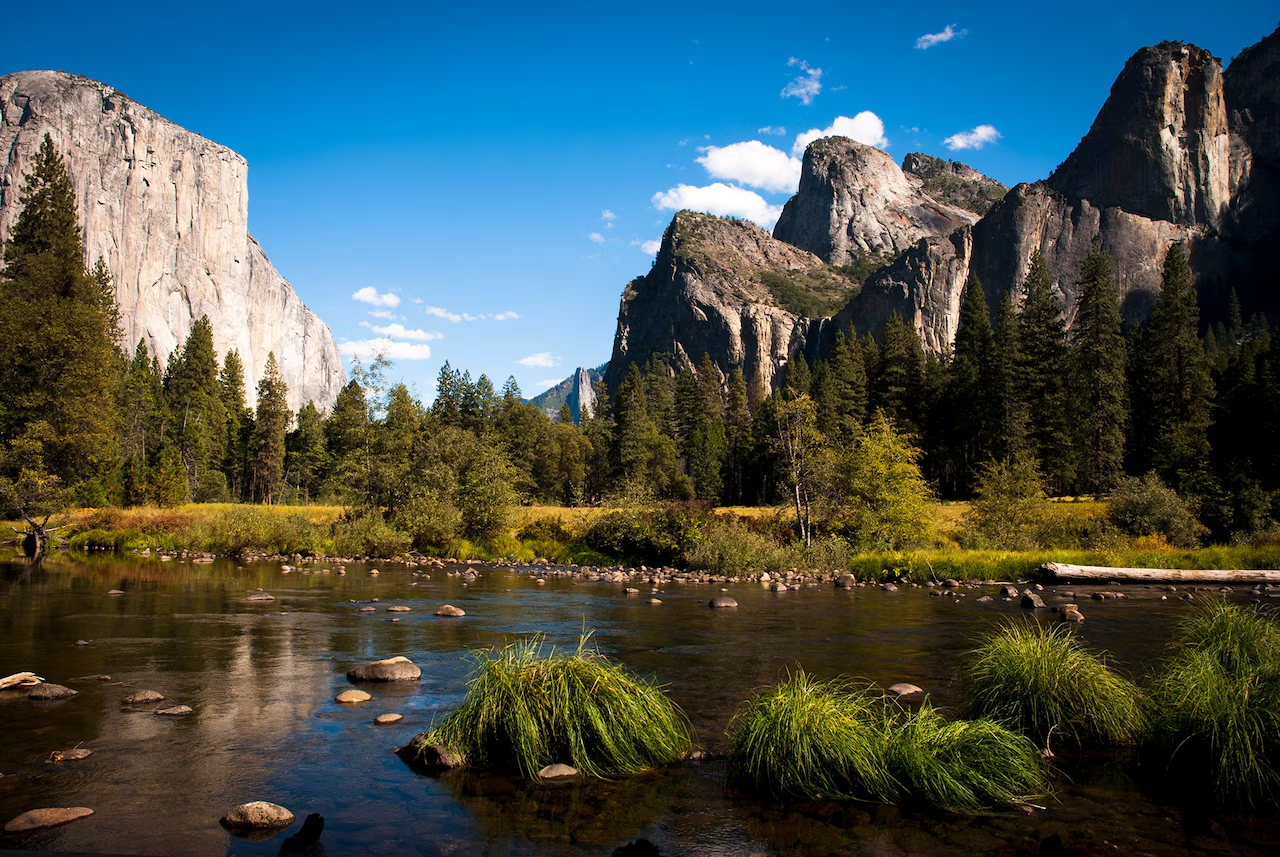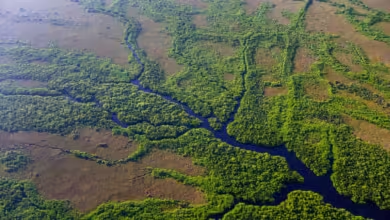
One of the most spectacular natural areas on Earth, Yosemite National Park is renowned for its towering granite cliffs, imposing waterfalls, ancient sequoia forests, and varied ecosystems. Situated in the heart of California’s Sierra Nevada mountains, this breathtaking natural wonder spans 1,189 square miles and is officially designated as a UNESCO World Heritage Site. Over 4 million visitors travel to Yosemite every year to take advantage of its exceptional natural beauty and outdoor activities.
Geography and Location
In the center of California’s Sierra Nevada mountain range sits Yosemite National Park. With a wide expanse of 1,189 square miles, the park presents a diverse range of landscapes, such as meadows, woods, rivers, lakes, mountains, and glaciers. The park offers a variety of habitats, from dense forests to high-altitude alpine scenery, thanks to its height range of 2,000 feet to nearly 13,000 feet.
Iconic Natural Features
Granite Dwellings
El Capitan and Half Dome are two of Yosemite’s enormous granite cliffs that are well-known. These recognizable natural monuments draw tourists and rock climbers from all over the world. Climbers particularly like El Capitan because of its sheer vertical face, which is well-known.
rivers and waterfalls
The park is home to some of the most breathtaking waterfalls on Earth, including as Vernal Fall, Bridalveil Fall, and Yosemite Falls. With a height of more than 2,400 feet, Yosemite Falls is the highest waterfall in North America. The park is traversed by the Merced River, which offers glistening streams and breathtaking vistas from the riverbank.
Giant Sequoia Groves
The largest living trees on Earth, huge sequoia trees, can be found in old groves in Yosemite. The greatest of these groves, Mariposa Grove, is home to more than 500 mature sequoias, some of which are over two millennia old. These magnificent trees serve as representations of tenacity and durability.
Mountains, Lakes, and Glaciers
Yosemite is known for its waterfalls and cliffs, but it’s also home to beautiful alpine lakes like Tenaya Lake and Mirror Lake. Stunning views can be had from the tall summits of the Sierra Nevada, such as Mount Lyell and Mount Dana. Despite the park’s glaciers having largely receded over time, the park’s untamed beauty is enhanced by the glacially-carved valleys that they have left behind.
Biodiversity in Yosemite
Life of Animals
The wildlife in Yosemite National Park is incredibly diverse. In the park, it’s typical to see coyotes, elk, and black bears. Though they are more elusive, foxes, bobcats, and cougars can also be found roaming the park. Among the many songbird species that can be observed by birdwatchers are owls and peregrine falcons.
Plant Life
Towering sequoias and exquisite alpine flowers are among the park’s diverse flora. Yosemite’s meadows are especially colorful in the spring and summer, when a profusion of wildflowers blooms. Hardy plants such as sedges and wild buckwheat flourish in the severe alpine environments.
Outdoor Activities in Yosemite
Trails for hiking
With more than 800 miles of paths to explore, Yosemite is a hiker’s dream come true. Everything from leisurely strolls through meadows to strenuous ascents to the summit of Half Dome is available for all skill levels. The most well-liked trail in the park is the Mist Trail, which goes to Vernal and Nevada Falls.
Camping and Seeing Wildlife
Yosemite offers 13 campgrounds for guests to enjoy, making camping a popular activity there. Seeing wildlife in its natural habitat is another popular attraction, particularly in the park’s more isolated sections.
Climbing Rocks
Climbers from all around the world travel to Yosemite to scale its granite walls, which are regarded as the home of modern rock climbing. El Capitan is one of the most well-known climbing locations on the planet because of its approximately 3,000-foot vertical face.
Traveler Information
Statistics on Annual Visits
Yosemite is one of the most frequented national parks in the US, with over 4 million people annually. Come to enjoy its rich biodiversity, engage in outdoor activities, and appreciate its natural beauty.
Highways and Availability
With 350 miles of highways, the park offers access to well-known locations like Mariposa Grove, Glacier Point, and Yosemite Valley. The park is open all year round, though snowfall may cause some routes to close in the winter.
Preserving the Unspoiled Beauty of Yosemite
In addition to being a popular destination for recreation, Yosemite is a protected region with a strong emphasis on conservation. The management of the park aims to maintain its natural ecosystems by controlling wildlife populations and safeguarding the old sequoias. Threats still exist, though, from issues like rising tourism, pollution, and climate change.
Cultural Significance and History
Yosemite has a long history; before it was designated as a national park, native people lived there for thousands of years. Among the first people to live there were the Ahwahneechee people. President Abraham Lincoln declared Yosemite to be protected in 1864, and in 1890 it was designated as a national park.
The World Heritage Status of Yosemite
Yosemite National Park’s worldwide significance was acknowledged in 1984 when it was named a UNESCO World Heritage Site. This esteemed status was granted to the park because of its exceptional blend of geological features, biodiversity, and scenic beauty, making it a treasure of both national and international significance.
In summary
A veritable wonder of the natural world is Yosemite National Park. With its massive granite cliffs and historic sequoia forests, it provides tourists with an experience that is unmatched. Yosemite has something for everyone, regardless of your interests—everyone from animal enthusiasts to passionate hikers to people who just enjoy the beauty of nature. It is our responsibility to guarantee that future generations can enjoy this amazing park by encouraging responsible tourism and supporting conservation activities.
Frequently Asked Questions (FAQs)
- What is the best time to visit Yosemite?
- The best time to visit Yosemite is in late spring or early summer when the waterfalls are at their peak, and the park is lush with wildflowers.
- How can I see the giant sequoias in Yosemite?
- The best place to see giant sequoias in Yosemite is at Mariposa Grove, where over 500 mature sequoias can be found.
- Are there guided tours available in Yosemite National Park?
- Yes, there are several guided tours available, including bus tours, walking tours, and specialized wildlife observation tours.
- What are the most famous landmarks in Yosemite?
- The most famous landmarks include El Capitan, Half Dome, Yosemite Falls, Bridalveil Fall, and the giant sequoias in Mariposa Grove.
- Can I camp inside Yosemite National Park?
- Yes, Yosemite offers 13 campgrounds,

